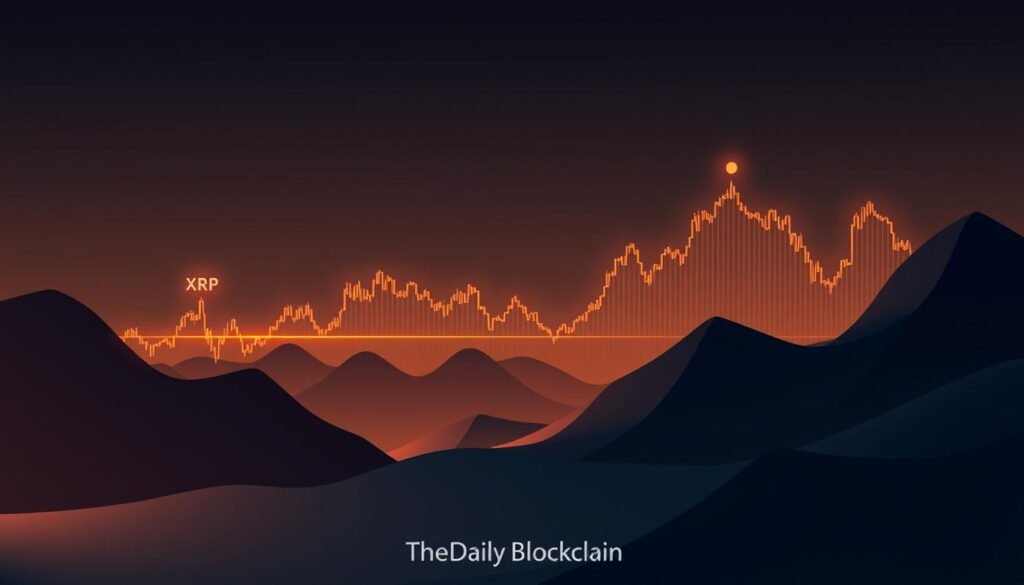Surprising fact: CME futures for this token recently topped $1 billion in open interest, and prediction markets price roughly an 82% chance of a spot ETF by end‑2025 — a scale few expected.
Today the token trades in a tight $2.73–$2.82 range with neutral technicals and a Fear & Greed reading of 46. Consolidation below $3.00 has capped upside since late August, but tight ranges often precede strong moves as liquidity concentrates near that level.
Derivatives and structure matter: open interest sits near $2.87B and funding rates have risen, showing more risk taking. Key levels to watch are support around $2.75–$2.66 and resistance at $2.99/$3.25/$3.43. RSI near 40 and a flattening MACD point to waning downside, not a confirmed reversal.
We will link on‑chain and derivatives data with price action, market capitalization effects, and real‑world moves from Ripple’s card rewards to build a grounded analysis for readers.
Key Takeaways
- Price sits near $2.73–$2.82 with neutral technicals and cautious sentiment today.
- Consolidation under $3 can limit gains but may set up range expansion.
- Derivatives flows — ~$2.87B OI and rising funding — show growing risk appetite.
- Watch support at $2.75–$2.66 and resistance at $2.99/$3.25/$3.43 for near‑term direction.
- ETF odds and CME OI could broaden market capitalization and liquidity if realized.
Today’s Market Snapshot: Price, Momentum, and Sentiment
Trading remains compressed near $2.73–$2.82, signaling concentrated liquidity and low churn. The 30‑day realized volatility sits at 4.45%, which matches the narrow intraday band and explains muted trading action today.
Current price action
The session shows 10 green days out of 30 (about 33%), suggesting subdued upside participation. The Fear & Greed Index reads 46 (Fear), while sentiment models register neutral conditions.
Momentum and chart context
Short‑term momentum is tepid: the 14‑day RSI is near 40.05 and the 50‑day SMA sits around $3.11 overhead. The 200‑day SMA at roughly $1.99 provides longer-term support.
- Range behavior: price is respecting a micro‑range; incremental volume could quickly test adjacent levels.
- Trader focus: the gap to the 50‑day average helps infer mean reversion versus trend continuation.
- Risk note: in a neutral backdrop, small data surprises can swing short‑term momentum disproportionately.
Bottom line: today’s signals do not confirm a decisive move but set a baseline for short‑horizon trading. Traders should wait for RSI to lift into the mid‑40s and for sustained closes above nearby moving averages to favor a short‑term bullish case.
Multi‑Timeframe Technical View: Trend, Support, and Resistance
Examining daily and weekly charts reveals level clusters that will likely steer near‑term action. These pivot points map where liquidity sits and define clear invalidation levels for traders.
Immediate support stack: classical pivots mark support at $2.75, $2.72, and $2.66. A nearby swing at ~ $2.74 serves as the short‑term line of defense; a clean break below opens a path toward ~$2.40, a prior accumulation pocket.
First‑tier resistance: intraday caps appear at $2.84, $2.90, and $2.93. These levels often govern stop placement and intraday reactions as the market tests demand and supply.
Broader runway: the band from $2.99 through $3.25 to $3.43 is the range bulls must clear to flip momentum. A decisive daily or weekly close above ~$3.43 would likely unlock a move toward the mid‑$3.60s and increase the odds of follow‑through.
Indicators: RSI sits near 39–40 and the MACD has flattened, which suggests downside thrust is fading but not reversed. Recent spinning tops near resistance signal indecision and the potential for either rejection or breakout at these confluences.
- Map the support stack ($2.75/$2.72/$2.66) as the immediate risk anchors.
- View $2.84–$2.93 as short‑term reaction zones where liquidity concentrates.
- Use clustered closes above $3.43, not single spikes, to validate a momentum shift.
Actionable takeaway: combine level‑by‑level reads with momentum shifts to refine any price prediction. Define invalidation below support and stage progressive targets above resistance to manage risk in this tight range.
Moving Averages Checkup: 50‑Day vs. 200‑Day Signals
A look at short and long moving averages helps separate daily noise from the market’s broader direction. These averages act as dynamic reference points that traders use to judge momentum and risk.
50‑Day as a near‑term headwind
The 50‑day SMA sits near $3.11 and currently trades above spot, serving as a dynamic resistance. Reclaiming this level with multiple consecutive closes often precedes sustained upside and validates a change in short‑term bias.
200‑Day cluster and longer‑term support
The 200‑day SMA is near $1.99 while the 200‑day EMA sits around $2.03–$2.05. Both have trended higher through 2025 and offer durable support that reflects improving broad trend health.
Daily vs. weekly context
Daily reads are mixed to mildly bullish, while weekly 50/200 averages slope upward and sit below price. That contrast helps traders filter short‑term whipsaws from a constructive longer‑term backdrop.
- Use the 50/200 relationship to frame mean‑reversion versus trend continuation hypotheses.
- Pair MA signals with key levels ($2.99/$3.25/$3.43) and volume for higher‑quality entries and exits.
- Note: moving averages lag—combine them with structure and on‑chain data for sharper prediction.
| Moving Average | Level | Role |
|---|---|---|
| 50‑day SMA | $3.11 | Short‑term resistance; reclaiming it boosts confidence in upside |
| 200‑day SMA | $1.99 | Long‑term support; indicates improving trend health |
| 200‑day EMA | $2.03–$2.05 | Smoother support cluster; useful for timing risk‑reward |
Takeaway: Near‑term the market faces a headwind with the 50‑day above price, but the rising 200‑day cluster underpins a constructive long‑term setup. A clean move back above the 50‑day SMA would shift the short‑term bias toward a higher probability price prediction.
Derivatives and Open Interest: Reading Leverage and Risk
Derivatives flow has become a primary lens for reading leverage and risk in today’s market. Traders and investors now watch open interest and funding to understand who carries exposure and where liquidations may cluster.
Positioning snapshot
Open interest sits near $2.87B, a level that signals elevated leverage across venues. Funding rates have risen from 0.0114 to 0.0159, showing more retail longs are stepping in while whales pare holdings.
Why this matters
Rising OI and tightening funding often amplify volatility and can trigger abrupt swings in price when crowded trades unwind.
- Retail vs. whales: a supply handoff to smaller holders can cap rallies unless fresh capital absorbs the selling pressure.
- CME influence: futures on the exchange quickly exceeded $1B OI, expanding institutional access and improving price discovery and depth.
- Trading mechanics: basis, funding drift, and liquidation clusters create action points that traders should map into risk plans.
| Metric | Value | Implication |
|---|---|---|
| Open Interest | $2.87B | Elevated leverage; larger swings possible |
| Funding rates | 0.0114 → 0.0159 | Retail longs increasing; mean‑reversion risk |
| CME futures OI | > $1B | Broader institutional access; improved discovery |
Actionable takeaway: expect higher realized volatility when perpetual positioning climbs. Use defined invalidations and conservative leverage to manage derivatives‑driven whipsaw. If institutions resume inflows, positioning itself could fuel upside squeezes; however, continued whale supply could still cap gains.
ETF Odds, Liquidity, and Market Capitalization
An ETF approval would be a structural event that could reshape liquidity, spreads, and investor access. Prediction markets currently assign roughly 82% odds of a spot ETF clearing by the end of 2025. That probability matters because it shifts how participants model capital formation and price targets today.
Why approval changes the calculus
A listed ETF widens access for traditional investors and can create steady inflows. More buyers from pension, wealth, and mutual fund channels tend to raise market capitalization and smooth episodic swings.
Liquidity effects: deeper order books usually compress bid‑ask spreads and cut slippage during high volume. That makes trading cheaper and encourages larger allocations from institutional desks.
- CME futures growth signals institutional readiness and often precedes spot product launches.
- Surveillance, custody, and approval structure remain key factors that shape timing and scope.
- Fees and management rates can tilt investor mix, but accessibility is the dominant force.
| Impact | Likely outcome |
|---|---|
| Market capitalization | Higher as buy‑side participation scales |
| Liquidity & spreads | Deeper books, tighter spreads, less slippage |
| Price formation | Cleaner discovery but not guaranteed persistent upside |
Outlook: odds are strong but not definitive. Scenario planning should bracket both approval and denial. If approval aligns with supportive macro and crypto market conditions, price trajectories and capitalization can re‑rate significantly; if not, the market may revert to present patterns.
Adoption Trends: Ripple, Payments, and Real‑World Utility
Ripple’s recent consumer push ties tangible card rewards to on‑chain activity. The new credit card program offers 4% cashback on fuel and EV charging and up to 10% with select merchants. That makes integration visible to everyday users.
This kind of reward can lift demand by giving a direct use case for the token beyond trading. When consumers spend and redeem, activity and liquidity move from wallets to real commerce.

Payments role and competing solutions
The token still plays a role in cross‑border settlement, but the payments narrative faces rivals from newer settlement tech. Banks and fintechs weigh cost, speed, and compliance when choosing rails.
| Adoption vector | Why it matters | Near‑term effect |
|---|---|---|
| Card rewards | Drives consumer spend | Boosts everyday activity |
| Partnerships & exchanges | Expand access and on‑ramps | Wider liquidity and demand |
| Derivatives growth | Frames trading demand | Higher turnover, separate from payments |
Partnerships and broad exchange availability widen on‑ramps. That diversifies users and can smooth engagement across cycles. Still, adoption compounds slowly and meaningful data points usually show over quarters, not days.
Trends snapshot: ecosystem breadth and integrations are leading indicators. Together, merchant rewards, settlement use cases, and exchange depth can support durable value accrual in the market.
Regulatory and Legal Context Shaping Outlook
Policy progress in major jurisdictions has quietly reshaped the risk calculus for large custodians and funds. In 2025, favorable U.S. rulings for Ripple improved confidence among retail and institutional investors. That legal clarity lifted sentiment and supported a steadier price backdrop.
Recent legal tailwinds in the United States and clarity abroad
U.S. outcomes in 2025 reduced headline uncertainty and removed a major barrier to onboarding. Meanwhile, Europe and Asia clarified rules that enable corridor‑specific remittance and B2B transfers.
Why regulatory momentum matters for institutional adoption
Institutions evaluate compliance certainty, custody standards, and surveillance before allocating capital. Clear rules lower operational risk and make it easier to meet internal mandates.
- Improved conditions often tighten spreads and deepen liquidity as larger investors join the market.
- Regulated reporting around issuance and escrow changes how supply is perceived.
- Analysts and legal updates shape expectations and the timing of adoption milestones.
| Factor | Effect |
|---|---|
| Compliance clarity | Faster onboarding by investors |
| Custody standards | Lower operational risk |
| Market surveillance | Improved integrity and trust |
Takeaway: steady policy progress matters more than headlines. Positive developments tend to lift adoption and price gradually, and conditions will still vary by jurisdiction—so tailored strategies remain essential.
Comparative Market Lens: Bitcoin, Ethereum, and Altseason Dynamics
Cross‑market cues show bitcoin slipping under the ~$110K mark while some large‑cap altcoins hold key ranges.
BTC weakness below ~$110K contrasts with the token’s resilience around $2.80–$3.00. That relative strength frames short‑term narrative for traders and analysts.
Rotation mechanics and risks
When Ethereum leads a rotation, capital often shifts from lagging coins into ETH. This rotation can create temporary outflows that pressure price xrp performance even if fundamentals remain intact.
Higher‑time‑frame hurdle
Clearing ~$3.50 on a two‑week candle is the milestone long‑term chartists watch. Sustained closes above that level would unlock higher targets and signal a real range expansion.
- Momentum breadth across majors sets altseason odds and risk appetite.
- Volatility often compresses before rotation, then expands quickly as leaders emerge.
- Correlation shifts — a decoupling from large caps — would change directional expectations.
| Factor | Current read | Implication |
|---|---|---|
| Bitcoin | Below ~$110K | Reduces broader risk appetite |
| Ethereum leadership | Potential | May drain midsized alts temporarily |
| Two‑week close | ~$3.50 | Pivotal for bullish confirmation |
Neutral view: the near term stays constructive if key levels reclaim. If majors deteriorate, the token is vulnerable until leadership clarifies.

XRP Forecast: Near‑Term and Mid‑Cycle Price Scenarios
Near‑term models cluster the trading channel around $2.69–$3.28 into Q4 2025. Monthly averages from Sep–Dec center near $2.85–$3.12, giving traders a practical band to plan entries and exits.
Short term (present to Q4 2025)
The short‑term price range is $2.69–$3.28. Use that band to set targets, stops, and sizing rather than making all‑in bets. Momentum confirmation—RSI lift and volume expansion—would increase the odds of a sustained move higher.
Breakout path
For a bullish advance, sustained closes above $2.99, then $3.25 and $3.43 are required. Clearing those levels could re‑target the mid‑$3.60s and, with follow‑through, a stretch toward $6.00.
Failure path
Loss of $2.74 likely tests $2.66, with a deeper slide to ~$2.40 where prior accumulation appeared. That zone can act as a tactical buy area for longer‑term investors.
“Define invalidation points, scale exposure, and use structure to manage risk.”
| Horizon | Range / Targets | Action |
|---|---|---|
| Short term | $2.69–$3.28 | Trade the range; set stops |
| Breakout | $3.43 → $3.60s → $6.00 | Scale into strength |
| Failure | $2.66 → $2.40 | Watch accumulation |
Practical note: use staggered entries, respect invalidations, and reassess if macro or sector conditions deteriorate. The token could also consolidate in this band longer, building a cleaner base for later moves.
Long‑Term Projections and Key Catalysts to Watch
Several long‑horizon models show mid‑single to high‑single digit averages from 2026–2030, with an upper band approaching $9.5 by 2030 if momentum and fresh participation persist.
2026–2030 algorithmic ranges
Range view: a practical long‑term band centers near ~$5–$9.5 if institutional flows and steady demand continue. Higher milestones such as $7, $11, $18, and $27 appear in extension scenarios but should be treated as conditional markers, not base cases.
Structural drivers
Primary catalysts: a spot ETF decision, deeper institutional allocation, and clearer global integration for payments and custody can lift market depth and improve price discovery.
Risk factors
Major risks include large‑holder supply overhangs and leverage imbalances that can create sharp, temporary dislocations.
- Supply: staged distribution from big wallets can cap rallies until absorbed.
- Leverage: crowded positions may amplify downside when funding shifts.
- Macro: tighter liquidity cycles reduce risk appetite and mute sustained trends.
Guardrails: align allocations to time horizon, set invalidation points, and track custody, payments corridor rollouts, and institutional tooling as validation signals.
“Expect probabilistic outcomes: the token could outperform base paths if multiple tailwinds converge, but plan for range and timing uncertainty.”
Conclusion
Market action today sits inside a narrow band, leaving traders to map triggers rather than bet on momentum.
The balanced xrp forecast is range‑bound near $2.73–$2.82, with neutral sentiment (Fear & Greed 46) and 4.45% realized volatility. Key supports sit at $2.75/$2.72/$2.66 and resistance clusters at $2.84–$2.93 and $2.99/$3.25/$3.43.
Moving averages matter: the 50‑day (~$3.11) remains overhead while the 200‑day (~$1.99) underpins the market. Derivatives flows (OI ≈ $2.87B; funding up to 0.0159; CME > $1B) are active signals for near‑term swings.
Price prediction outcomes hinge on catalysts — ETF odds, institutional flows, and steady adoption via payments. Investors and analysts should favor a process: define levels, await momentum confirmation, and manage risk to align trading with probabilities.
FAQ
What is the current market snapshot for XRP?
Today the token trades around .73–.82 with about 4.45% intraday volatility. It has posted approximately 10 green days out of the last 30, and market sentiment sits near neutral — the Fear & Greed Index reads 46 (Fear).
Which technical levels should traders watch for near‑term support and resistance?
Key supports cluster near .75, .72 and .66 with a lower risk zone around .40 if those break. Immediate overhead resistance appears at .84, .90 and .93, with higher barriers from .99 up to .43 that would need clearing to shift momentum higher.
What do momentum indicators show right now?
Momentum looks mixed: the RSI is near 40, MACD is flattening, and price action has produced spinning‑top candles near resistance. That combination suggests limited directional conviction until a clear breakout or breakdown occurs.
How do moving averages influence the outlook?
The 50‑day SMA sits near .11 and acts as a short‑term headwind. The 200‑day SMA/EMA is rising closer to .00, which supports the longer‑term trend. Overall, daily signals are mixed while weekly structure remains relatively supportive.
What do derivatives and open interest tell us about leverage and risk?
Open interest across derivatives is around .87B with funding rates ticking higher, indicating elevated long exposure from retail and some redistribution by larger holders. Growing CME futures open interest above
FAQ
What is the current market snapshot for XRP?
Today the token trades around $2.73–$2.82 with about 4.45% intraday volatility. It has posted approximately 10 green days out of the last 30, and market sentiment sits near neutral — the Fear & Greed Index reads 46 (Fear).
Which technical levels should traders watch for near‑term support and resistance?
Key supports cluster near $2.75, $2.72 and $2.66 with a lower risk zone around $2.40 if those break. Immediate overhead resistance appears at $2.84, $2.90 and $2.93, with higher barriers from $2.99 up to $3.43 that would need clearing to shift momentum higher.
What do momentum indicators show right now?
Momentum looks mixed: the RSI is near 40, MACD is flattening, and price action has produced spinning‑top candles near resistance. That combination suggests limited directional conviction until a clear breakout or breakdown occurs.
How do moving averages influence the outlook?
The 50‑day SMA sits near $3.11 and acts as a short‑term headwind. The 200‑day SMA/EMA is rising closer to $2.00, which supports the longer‑term trend. Overall, daily signals are mixed while weekly structure remains relatively supportive.
What do derivatives and open interest tell us about leverage and risk?
Open interest across derivatives is around $2.87B with funding rates ticking higher, indicating elevated long exposure from retail and some redistribution by larger holders. Growing CME futures open interest above $1B suggests increasing institutional participation and tighter price discovery.
Could an ETF approval change market dynamics?
Yes. Prediction markets currently price about an 82% chance of a spot ETF approval by the end of 2025. An approved product would likely boost demand, raise market capitalization, and tighten bid‑ask spreads as institutional flows increase.
What adoption trends are material for future price action?
Adoption signals include Ripple’s expanding payment integrations — for example, card partnerships offering cashback on fuel and EV charging — and continued work on cross‑border settlement. Real‑world utility strengthens demand and investor confidence over time.
How does the regulatory environment affect prospects?
Recent legal tailwinds in the U.S. and clearer rules abroad reduce uncertainty, which helps institutional adoption. Regulatory momentum lowers perceived legal risk and can unlock larger pools of capital if clarity persists.
How does this token compare with Bitcoin and Ethereum performance?
The asset has shown relative resilience in the $2.80–$3.00 band while Bitcoin trades under ~$110K. Rotation toward or away from ETH and BTC can drive short‑term moves; a strong lead from Ethereum often sparks broader altcoin rallies.
What are realistic near‑term price scenarios?
Short‑term bands project roughly $2.69–$3.28 given current volatility. A decisive reclaim of $2.99–$3.43 would re‑target the $3.60s and beyond; losing $2.74 risks a slide toward $2.66 or deeper accumulation near $2.40.
What could drive long‑term gains toward higher ranges by 2026–2030?
Sustained momentum tied to structural catalysts — ETF approval, steady institutional flows, and broader global integration — could push price into multi‑dollar ranges (roughly $5–$9.50 in bullish algorithmic scenarios). Major risks include large whale sell‑pressure, leverage imbalances, and tightening macro liquidity.
What are the main risk factors traders should monitor?
Watch whale distribution and concentrated supply, rapid increases in leverage or funding stress, unexpected regulatory setbacks, and macro moves that drain risk appetite. These factors can amplify volatility and reverse bullish setups quickly.
Could an ETF approval change market dynamics?
Yes. Prediction markets currently price about an 82% chance of a spot ETF approval by the end of 2025. An approved product would likely boost demand, raise market capitalization, and tighten bid‑ask spreads as institutional flows increase.
What adoption trends are material for future price action?
Adoption signals include Ripple’s expanding payment integrations — for example, card partnerships offering cashback on fuel and EV charging — and continued work on cross‑border settlement. Real‑world utility strengthens demand and investor confidence over time.
How does the regulatory environment affect prospects?
Recent legal tailwinds in the U.S. and clearer rules abroad reduce uncertainty, which helps institutional adoption. Regulatory momentum lowers perceived legal risk and can unlock larger pools of capital if clarity persists.
How does this token compare with Bitcoin and Ethereum performance?
The asset has shown relative resilience in the .80–.00 band while Bitcoin trades under ~0K. Rotation toward or away from ETH and BTC can drive short‑term moves; a strong lead from Ethereum often sparks broader altcoin rallies.
What are realistic near‑term price scenarios?
Short‑term bands project roughly .69–.28 given current volatility. A decisive reclaim of .99–.43 would re‑target the .60s and beyond; losing .74 risks a slide toward .66 or deeper accumulation near .40.
What could drive long‑term gains toward higher ranges by 2026–2030?
Sustained momentum tied to structural catalysts — ETF approval, steady institutional flows, and broader global integration — could push price into multi‑dollar ranges (roughly –.50 in bullish algorithmic scenarios). Major risks include large whale sell‑pressure, leverage imbalances, and tightening macro liquidity.
What are the main risk factors traders should monitor?
Watch whale distribution and concentrated supply, rapid increases in leverage or funding stress, unexpected regulatory setbacks, and macro moves that drain risk appetite. These factors can amplify volatility and reverse bullish setups quickly.



